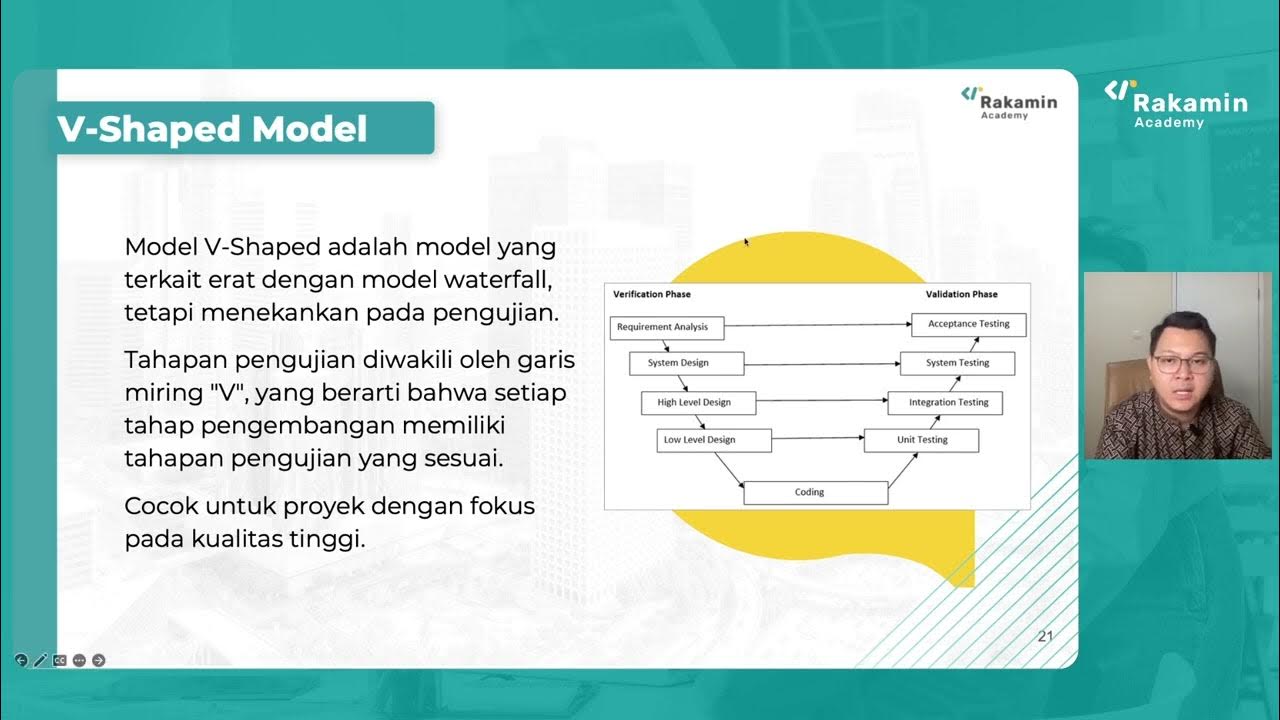SE 5 : Iterative Development Model | Complete Explanation | Software Engineering
Summary
TLDRIn this session, Vishali discusses the iterative development model, a key concept in software engineering. Unlike the waterfall model, the iterative model allows for changes throughout the development process, making it suitable for large projects with evolving requirements. The video covers the phases of the model, including requirement gathering, design, coding, testing, review, and deployment. It also highlights when to use this model, its advantages, such as flexibility and early error detection, and disadvantages like the need for more resources and uncertainty in deadlines.
Takeaways
- 📚 Iterative model allows software to be developed in multiple iterations, with each iteration involving design, coding, and testing.
- 🔄 After each iteration, the product is reviewed to determine if new changes or features are required before moving to the next iteration.
- ✅ Iterative model is suitable when customer requirements are not fixed and may change during the development process.
- 📱 Example: Apps like WhatsApp frequently update with new features and versions, similar to how iterative models work with continuous improvements.
- 💡 This model is commonly used for large projects where new technologies and frameworks are applied in each iteration.
- ⚙️ High-risk features can be addressed in future iterations if errors or updates are found in earlier ones.
- 🛠️ Key phases of the iterative model include requirement gathering, design, coding, testing, review, deployment, and maintenance.
- 📊 Advantages: Testing and debugging occur during small iterations, and the model allows parallel development with flexible requirements.
- 🚫 Disadvantages: Not suitable for smaller projects, requires more resources, and has no fixed budget or project deadline due to changing requirements.
- 🚀 Final deployment and maintenance occur after all iterations are completed, ensuring the product meets customer needs.
Q & A
What is the iterative development model?
-The iterative development model is a software development process where the product is built and improved in repeated cycles or iterations. Each iteration includes phases like design, coding, and testing, and after every iteration, the product is reviewed for improvements or additional features.
How does the iterative model differ from the waterfall model?
-In the iterative model, customer requirements are not fixed and can change during the development process, allowing for multiple updates and improvements. In contrast, the waterfall model follows a linear approach where requirements are fixed from the beginning, and no changes are made after the initial phase.
When should the iterative model be used?
-The iterative model is best suited for large software projects where requirements are expected to evolve over time. It is also useful when new technologies are being introduced or when there are high-risk features that may change in future iterations.
What are the main phases in the iterative model?
-The main phases in the iterative model include: 1) Requirement Gathering and Analysis, 2) Design, 3) Coding, 4) Testing, 5) Review, and 6) Deployment and Maintenance.
What is the role of the review phase in the iterative model?
-The review phase occurs after each iteration, where the product is evaluated to check if it meets customer requirements. If new features or updates are needed, the process moves to the next iteration, repeating design, coding, and testing steps.
Can you provide an example of an iterative model in action?
-A good example of the iterative model is WhatsApp updates. After an update, new features may be added, and over time, further updates are released with more new features and improvements, similar to how iterations work in the iterative development model.
What are the advantages of using the iterative model?
-The main advantages include: testing and debugging are done in small iterations, allowing for early identification and resolution of issues; the ability to adjust to changing customer requirements; parallel development is possible; and limited time is spent on documentation.
What are the disadvantages of the iterative model?
-The disadvantages include: it is not suitable for smaller projects, more resources may be required, the continuous change in requirements makes budgeting difficult, and the project completion date is uncertain due to ongoing iterations.
Why is the iterative model not suitable for smaller projects?
-The iterative model is not ideal for smaller projects because it involves multiple iterations, which can require more resources and time than necessary. For smaller projects, the waterfall model, which has fixed requirements, is often more efficient.
What is the significance of changing requirements in the iterative model?
-In the iterative model, changing requirements are expected and accommodated. This flexibility allows developers to incorporate new features and updates during the development process, making the model well-suited for projects where customer needs evolve.
Outlines

Esta sección está disponible solo para usuarios con suscripción. Por favor, mejora tu plan para acceder a esta parte.
Mejorar ahoraMindmap

Esta sección está disponible solo para usuarios con suscripción. Por favor, mejora tu plan para acceder a esta parte.
Mejorar ahoraKeywords

Esta sección está disponible solo para usuarios con suscripción. Por favor, mejora tu plan para acceder a esta parte.
Mejorar ahoraHighlights

Esta sección está disponible solo para usuarios con suscripción. Por favor, mejora tu plan para acceder a esta parte.
Mejorar ahoraTranscripts

Esta sección está disponible solo para usuarios con suscripción. Por favor, mejora tu plan para acceder a esta parte.
Mejorar ahoraVer Más Videos Relacionados

SE 9 : Spiral Model | Complete Explanation with Example | Software Engineering Full Course

SE 1 : Introduction to Software Engineering | Nature of Software | SE Full Course

RPL - 02 Proses Rekayasa Perangkat Lunak (Software Process)

Metodologi Pengembangan Software 2

Lecture 10: Incremental Model

Sub Topic 2
5.0 / 5 (0 votes)
